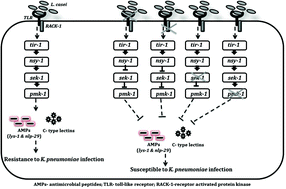Lactobacillus casei triggers a TLR mediated RACK-1 dependent p38 MAPK pathway in Caenorhabditis elegans to resist Klebsiella pneumoniae infection
Abstract
In the present study, the effect of Lactic Acid Bacteria (LAB) was investigated at the molecular level using the model organism Caenorhabditis elegans against Klebsiella pneumoniae. Out of the 13 LAB screened, Lactobacillus casei displayed excellent protective efficacy by prolonging the survival of K. pneumoniae-infected nematodes. Pretreatment with L. casei significantly decreased bacterial colonization and rescued K. pneumoniae-infected C. elegans from various physiological impairments. The concomitant upregulation of key immune genes that regulate the TLR, RACK-1 as well as the p38 MAPK pathway rather than the IIS and ERK pathway suggested that the plausible immunomodulatory mechanism of L. casei could be by triggering the TLR, RACK-1 and p38 MAPK pathway. Furthermore, the hyper-susceptibility of L. casei treated loss-of-function mutants of the tol-1, RACK-1 and p38 MAPK pathway (sek-1 and pmk-1) to K. pneumoniae infection and gene expression analysis suggested that L. casei triggered a TLR mediated RACK-1 dependent p38 MAPK pathway to increase host resistance and protect nematodes against K. pneumoniae infection.


 Please wait while we load your content...
Please wait while we load your content...